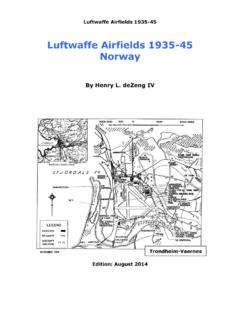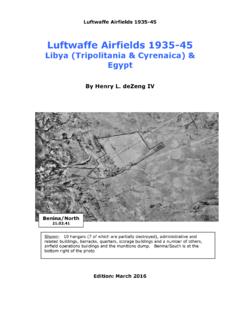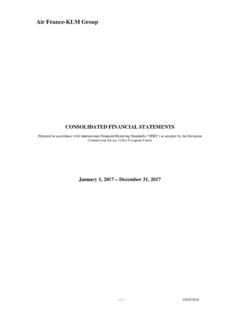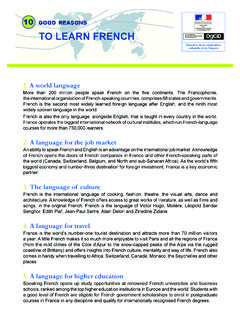Transcription of Luftwaffe Airfields 1935-45 France
1 Luftwaffe Airfields 1935-45 Luftwaffe Airfields 1935-45 France (with Corsica and Channel Islands)By Henry L. deZeng IVEdition: July 2014 Clermont-FerrandLuftwaffe Airfields 1935-45 Copyright by Henry L. deZeng IV (Work in Progress).(1st Draft 2014) Blanket permission is granted by the author to researchers to extract information from this publication for their personal use in accordance with the generally accepted definition of fair use laws. Otherwise, the following applies: All rights reserved. No part of this publication, an original work by the authors, may be reproduced, stored in or introduced into a retrieval system, or transmitted, in any form, or by any means (electronic, mechanical, photocopying, recording or otherwise), without the prior written permission of the author. Any person who does any unauthorized act in relation to this publication may be liable to criminal prosecution and civil claims for information is provided on an "as is" basis without condition apart from making an acknowledgement of authorship.
2 Luftwaffe Airfields 1935-45 AirfieldsFrance(with Corsica and Channel Islands)IntroductionConventions1. For the purpose of this reference, France generally means the territory belonging to it on 1 September 1939, including All spellings are as they appear in wartime German documents with the addition of diacritical pronunciation markings where See the General Introduction for matters concerning other conventions such as format, limitations of data, abbreviations, glossary, sources, to the beginning of the war on 1 September 1939, France had a very large network of Airfields , landing grounds and emergency landing grounds that stretched across the entire country. Many of the civil and military Airfields were well-developed and had been in use since World War I and before. Further development after the start of the war can be best summarized in a number of stages:1) France initiated an expansion program during 1939-40 to increase the number of air bases in the northeastern part of the country, and some of this work had been completed by June ) From June to September 1940, the Germans quickly built a large number of landing grounds along the Channel coast for use during the Air Offensive against England (The Battle of Britain).
3 By late 1940, there were more than 700 serviceable Airfields and landing grounds in the ) A major construction program to expand and develop the more permanent Airfields and the better landing grounds began around November 1940 and carried into 1941 and beyond. This included runways and runway extensions, artificial drainage of landing areas, aircraft shelters, aircraft dispersal areas, the decentralization and camouflaging of barracks and - 1 - Luftwaffe Airfields 1935-45supply installations and the installation of landing aids ( , beam approach, visual Lorenz systems, etc.).4) A gradual deactivation of landing grounds along the Channel coast began in early 1942 and then accelerated thereafter. These were usually obstructed with sawhorses, poles, logs and other portable objects which could be easily and quickly removed should orders be issued to reactivate the landing ground. The propelling force behind these deactivation measures was the German Army which feared Allied airborne and air-landing (glider) operations aimed at seizing these landing ) The deactivation program changed from temporary to quasi-permanent beginning in spring 1943 when the method of obstruction was changed to trenching to make the landing area unusable or outright abandonment and returning the land to cultivation.
4 By August 1943, the number of serviceable Airfields and landing grounds in France had been reduced from the 1940 total of 700 or so to approximately 210, of which only about 100 were fully stocked and in use on a daily ) Additional measures began at the end of 1943 and beginning of 1944 to expand the dispersing of aircraft by creating numerous satellite strips and alternate landing grounds in the vicinity of the larger, more permanent air bases. These were usually connected to the main airfield by a network of taxiways. The order for these measures came directly for Reichsmarschall G ring and dated 14 October 1943. Several hundred of these satellites and alternate landing grounds had been completed and were serviceable by the end of June 1944 while many others were still under construction.[Source: AFHRA A5259 ; Gundelach, Karl, The Effect of the Allied Air Attacks on the Ground Echelon of the Luftwaffe in Western Europe in 1944 , AFHRA manuscript (1956), 131p.]
5 , ListedA total of 726 Airfields , landing grounds and field airstrips are listed below, along with more than 200 satellites and alternate landing 2 - Luftwaffe Airfields 1935-45 AAbbeville-Drucat (FR) ( Le Plessiel) (50 08 30 N 01 50 43 E) General: airfield (Fliegerhorst) in NE France 4 km N of the city, km SW of the village of Drucat and 1 km S of Le Plessiel. History: In existence since 1922 for civil use with runway extended in 1936 for military purposes. The Luftwaffe further developed the runways and dispersal areas in 1941. Used principally by fighters, but none based there after Jan 43 in accordance with decisions made to withdraw Luftwaffe assets from the coastal : approx. 2010 x 1100 meters (2,200 x 1,200 yards). Surface and Runways: firm grass surface. The Luftwaffe expanded Drucat in 1941 and by 1942 there were 3 concrete runways measuring approx. 1650 meters (1,800 yards) aligned NW/SE, 1600 meters (1,750 yards) aligned NE/SW and 1465 meters (1,600 yards) aligned E/W x c.
6 50 meters (55 yards) each. Had paved assembly areas at N and W ends plus connecting taxiways and perimeter tracks. Permanently equipped for instrument landings with a flare-path, a beam approach system and all 3 runways outfitted with permanent illumination and visual Lorenz and Ammunition: had a refueling loop in the North dispersal area with bulk storage reportedly off the center of the S boundary. Ammunition dumps were believed to be in a small wood at the N end of the landing area and off the SE : full service and support facilities with at least one medium hangar, workshops and administrative buildings. Had a rail spur connection with the north dispersal area. Several small barrack huts, but station personnel mostly billeted in the villages of Drucat and Le Plessiel, with a few others in Abbeville. Dispersal: as of Nov 43, 24 large and 10 small aircraft shelters at the N end of the airfield, and 12 large at the S end. A few months later, 6 more small shelters were : by 1 Oct 43, the airfield was protected by a 6-gun and two 4-gun heavy Flak positions together with 21 light Flak positions, all of these within 3 km of the center of the field.
7 A system of defense trenches with numerous machine gun positions surrounded the airfield. Satellites and Decoys: Abbeville Port-le-Grand (50 10 00 N 01 44 50 E), dummy km NW of Abbeville-Drucat airfield and km N of the village of Port-le-Grand. Situated in open agricultural land and fully es-les-Cr cy (50 15 00 N 01 57 10 E), decoy c. km NNE of Abbeville-Drucat airfield. A former French landing ground with replica aircraft parked around the landing area that was obstructed with poles and wires. However, Estr es-les-Cr cy was listed as operational in May 1942 - 3 - Luftwaffe Airfields 1935-45with airfield code number 416. This was changed on 26 Jul 42 to code number 271 S (the S almost certainly an abbreviation for Scheinflugplatz (decoy field).Remarks: 29 Jun 40: Germans reported airfield attacked by approx. 15 Blenheims and 20 Spitfires 1 hangar set on fire and airfield Flak claimed 1 : airfield bombed and strafed frequently between July 1942 and May 1944.)
8 Most of these frequent attacks were carried out by 5 to 25 aircraft and were more harassing in nature than an attempt to knock out the airfield permanently. After the end of 1942, Drucat was used mainly to stage missions and as a fuel stop rather than as a permanent base for Jul 42: airfield issued new code number Aug 42: bombed by 22 B-17s - 4 men from the station command Apr 43: day raid by approx. 12 RAF Mosquitos no significant Mar 44: all 3 runways were mined during the preceding month and by 27 May the mines had been detonated and trenches dug across all remaining landing runs. Aug 44: airfield Units: 51 (Jun 40); 76 (Jun-Sep 40); Stab, II., 26 ( 40 Jan 43); 51 (Feb-Mar 41); Erprobungsgruppe 210 (Apr 41); 210 (Apr-May 41); 2 (Jun-Dec 41).Station Commands: E 16/VI (Jun 40 Mar 44); E(v) 227/XI (Apr 44 - ?).Station Units (on various dates on the airfield, in the city or nearby not complete): 64 ( ) (Jun 40); elements of 122(v) (Nov 42); elements of 157(v) (Jul 42); 314 (Jul-Aug 44); 417(v) (Dec 42, Feb 43); elements of 712 (Nov 42); elements of 773 (Aug 42); 880 (Aug 43); 958 (ETr.)
9 (Apr 43); 135/XII (Aug 44); elements of 18/XVII (Jul 42).[Sources: AFHRA A5260 (25 Apr 43 updated to 15 Mar 44); chronologies; BA-MA; NARA; PRO/NA; web site ]Achery (FR) (49 41 N 03 23 E) General: landing ground in NE France 22 km NW of Laon, 12 km NW of Laon-Couvron airfield and immediately SW of the village of Achery. History: prepared late spring/early summer 1944 and fully serviceable and in use by Aug 44. Surface and Dimensions: farm land measuring approx. 1280 x 365 meters (1400 x 400 yards). Infrastructure: none noted. Dispersal: aircraft could be concealed in hedges along the N, W and E boundaries.[Sources: (b)/Air Ministry Amendment dated 5 Aug 44 in BNA(PRO)/AIR 40]Achiet (FR): see Gr villers. Agen (FR) (Agen La Garonne) (44 10 30 N 00 35 49 E) - 4 - Luftwaffe Airfields 1935-45 General: airfield in SW France 120 km SE of Bordeaux in SW France and km SSW of the town of Agen on the Garonne : in existence since 1931 or possibly earlier.
10 Remained a French Air Force base after the armistice on 22 Jun 40. Dismantled and inactivated by the Germans in : approx. 1100 x 685 meters (1200 x 750 yards) and irregular in and Runways: Equipped with perimeter lighting and a visual beacon for night and Ammunition: no : had 14 hangars and hangar-size buildings, (1) on SW boundary 1 medium hangar used for aircraft in transit and 2 small hangars used as garages; (2) off the SW boundary 1 long narrow hangar-type building used for the storage of dismantled aircraft, 1 large 4 bay hangar used for the temporary storage of aircraft and vehicles, and 9 medium hangars used for storing dismantled aircraft and spare parts, and as a carpenter s shop, forge and a workshop, and the base motor pool and garages. A large concentration of barrack-type huts was immediately N of the airfield and these were used for accommodations for French and German personnel, for the station HQ and admin offices, messes, kitchen, dispensary, etc.













